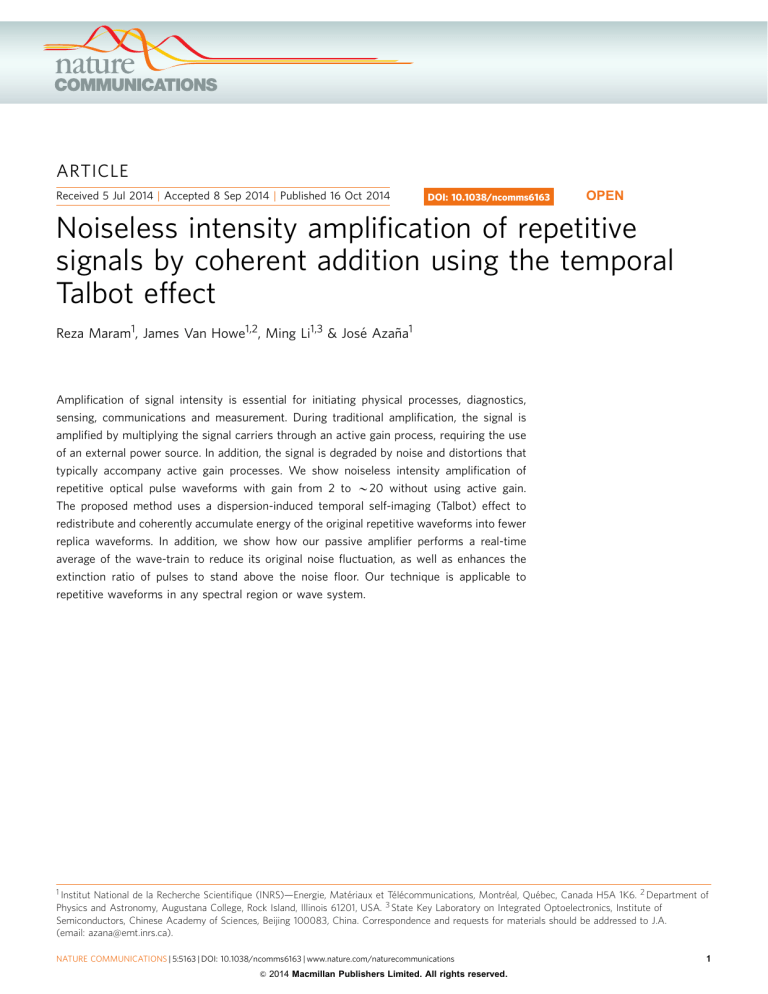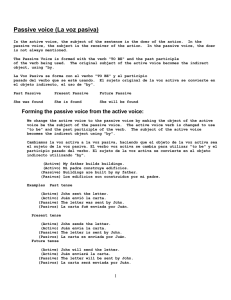Noiseless Intensity Amplification via Talbot Effect
Anuncio

ARTICLE Received 5 Jul 2014 | Accepted 8 Sep 2014 | Published 16 Oct 2014 DOI: 10.1038/ncomms6163 OPEN Noiseless intensity amplification of repetitive signals by coherent addition using the temporal Talbot effect Reza Maram1, James Van Howe1,2, Ming Li1,3 & José Azaña1 Amplification of signal intensity is essential for initiating physical processes, diagnostics, sensing, communications and measurement. During traditional amplification, the signal is amplified by multiplying the signal carriers through an active gain process, requiring the use of an external power source. In addition, the signal is degraded by noise and distortions that typically accompany active gain processes. We show noiseless intensity amplification of repetitive optical pulse waveforms with gain from 2 to B20 without using active gain. The proposed method uses a dispersion-induced temporal self-imaging (Talbot) effect to redistribute and coherently accumulate energy of the original repetitive waveforms into fewer replica waveforms. In addition, we show how our passive amplifier performs a real-time average of the wave-train to reduce its original noise fluctuation, as well as enhances the extinction ratio of pulses to stand above the noise floor. Our technique is applicable to repetitive waveforms in any spectral region or wave system. 1 Institut National de la Recherche Scientifique (INRS)—Energie, Matériaux et Télécommunications, Montréal, Québec, Canada H5A 1K6. 2 Department of Physics and Astronomy, Augustana College, Rock Island, Illinois 61201, USA. 3 State Key Laboratory on Integrated Optoelectronics, Institute of Semiconductors, Chinese Academy of Sciences, Beijing 100083, China. Correspondence and requests for materials should be addressed to J.A. (email: [email protected]). NATURE COMMUNICATIONS | 5:5163 | DOI: 10.1038/ncomms6163 | www.nature.com/naturecommunications & 2014 Macmillan Publishers Limited. All rights reserved. 1 ARTICLE W NATURE COMMUNICATIONS | DOI: 10.1038/ncomms6163 aveform amplification refers to a process by which the amplitude of the waveform is increased without affecting its other signal features, particularly temporal shape. Intensity amplification of the waveforms is necessary for increasing the peak power of signals for initiating physical processes, extracting information from the natural world and communications. Almost every information-bearing electronic signal used for diagnostics, sensing or fundamental measurement requires amplification between the source and the detector. Optical pulses amplified to high intensities are necessary for nonlinear microscopy1, materials processing2 and relativistic optical processes3 such as coherent X-ray generation, laser fusion and particle acceleration. In addition, optical amplification of signal intensity is critical for communications and is becoming increasingly important for current work in optical computing and optical information processing4–6. During active amplification, the signal is amplified directly by multiplying the signal carriers through an active gain process using an external power source7–14. Whereas active gain mechanisms are widely available for electrical and optical signals, suitable active gain processes for direct waveform amplification are limited over large regions of the electromagnetic spectrum and for other wave systems, such as mechanical, acoustic and quantum probability waves. Furthermore, for applications involving high-peak power pulse generation1–3, traditional active amplification is extremely inefficient. To generate high-peak power optical pulses, many pulses in a wave-train are intentionally thrown away, ‘pulsepicking,’ either prior to amplification15 or during the amplification process (regenerative amplification)16, to concentrate energy from the external source in fewer remaining output pulses. In such processes, typically 499% of the signal energy is thrown away before boosting. While absolute power consumption in high-peak power amplification is dominated by the pumps on the high-power boosting amplifier after pulsepicking, carelessly throwing away 99% of the signal prior to active amplification significantly reduces the signal-to-noise and is enough of a power hit to be a problem for high-peak power applications17. Finally, in applications where active amplification is employed, the active gain process typically contributes amplitude and phase noise, such as amplified spontaneous emission (ASE) noise or timing-jitter, and other signal distortions induced by limited-gain frequency bandwidth. Because an active gain process inherently amplifies input noise and also injects its own noise into a signal, the output signal-to-noise ratio (SNR) degrades. This degradation is encapsulated by a common figure-of-merit of any active amplifier—the noise figure18. The noise figure of an active amplifier is the ratio of the SNR of the input signal to the SNR of the output signal. Although phase-sensitive amplifiers have been shown capable of realizing low-noise amplification (with noise figures as low as 1 dB14), the amplification of weak signals by conventional amplifiers typically renders the signal totally undetectable due to the amplification and injection of noise. Coherent addition of repetitive optical pulses in a wave-train has been used in the past with the aim of overcoming the drawbacks described above. However, controlled coherent addition of many identical waveforms is an extremely challenging process. Previous methods are based on precisely timing and storing pulses in a high-finesse cavity17,19. As such, these methods require ultra-precise active phase control of the input signal envelope and carrier, that is, carrier-envelope phase stabilization, to stabilize the input waveforms to a cavity such that each pulse will add constructively. Otherwise, small phase misalignment in each pulse tends towards destructive interference. Although impressive results have been reported, these conditions are much too restrictive to be applied beyond a controlled lab environment. 2 Using optical pulses, we demonstrate a noiseless waveform amplification method for repetitive signals with experimental intensity gain from 2 to B20, without using an active gain process, through coherent addition. Our new concept of passive amplification exploits the intrinsic coherence revival times of periodic waveform trains provided by passive dispersive broadening, known as temporal ‘self-imaging’ or the temporal Talbot effect20 (illustrated in Fig. 1, top). In particular, passive amplification is achieved by effectively redistributing and coherently adding the overall input energy of a repetitive waveform signal into fewer waveforms, resulting in each output individual waveform to be an amplified copy of the input. Essentially, we implement a ‘lossless’ pulse-picking process using a suitable combination of phase-only temporal and spectral modulation operations, to preserve the overall input signal energy. This can be interpreted as coherently adding a desired number of identical copies on top of one another to produce the desired amplified output. However, in sharp contrast to previous pulse coherent-addition methods17,19, our technique implements a similar process without using a cavity and therefore without the associated stringent timing and stabilization conditions. The only condition on the input waveform is that it is repetitive and maintains coherence over the output repetition rate. Because our passive amplification technique for repetitive signals is based upon the fundamental process of linear superposition of waves, it can be applied to any wave system, introducing a method for multiplying signal intensity in systems where active gain processes for waveform amplification are limited or do not exist. Last but not least, we report numerical and experimental results to demonstrate that during passive intensity amplification, the SNR does not degrade. In fact, the proposed Talbot-based amplification technique improves random (white) intensity noise, ASE-like fluctuations, present on the input temporal signal, similarly to a real-time averaging process, as well as enhances the extinction ratio (ER) compared with the input waveform train in the time domain. In particular, consistent with simulation, we show experimentally that Talbot-based passive amplification increases the ER by approximately the passive gain factor, m, as well as performs a real-time average of the waveform train by about m averages. These noise-mitigating effects allow us to show in a side-by-side comparison in one of our experiments how Talbot amplification can extract a weak noisy signal nearly buried beneath a noisy background, whereas a typical active amplifier buries the signal further beneath the noise. We also anticipate that Talbot amplification improves pulse-to-pulse fluctuation21 and timing-jitter present on the input signal as the passive gain factor increases. This is consistent with previous experiments, which show improvement in timing-jitter and pulse-to-pulse fluctuation for simple self-imaging (passive gain factor of m ¼ 1)22,23. Noise mitigation using Talbot passive amplification therefore shows promise for further signal regeneration than the results presented in this report. Results Concept and operation principle. Figure 1 illustrates the concept of our passive amplification technique. We effectively exploit an ‘inverse temporal Talbot effect’ in which the final amplified temporal image is recovered from a previous multiplied selfimage. As shown in Fig. 1, top, in the standard temporal Talbot effect, a flat-phase repetitive input waveform (signal at z ¼ 0) is self-imaged, after dispersive propagation through a distance zT (integer Talbot distances). There also exists an infinite amount of fractional distances, given by the ‘Talbot Carpet’ (a map of all possible coherence revivals resembling a Persian rug in intricate but repeating patterns)20 that give multiplied self-images; see NATURE COMMUNICATIONS | 5:5163 | DOI: 10.1038/ncomms6163 | www.nature.com/naturecommunications & 2014 Macmillan Publishers Limited. All rights reserved. ARTICLE NATURE COMMUNICATIONS | DOI: 10.1038/ncomms6163 Temporal Talbot effect Power Phase P0′/3 T ′/2 Time (t) P0′/2 T′ P0′ T ′/3 T′ Dispersive propagation P0′ Propagation distance (z) Dispersive medium Output Input z = zT /2 z=0 z = 2zT /3 z = zT Passive waveform amplification 3T 3P0 Input waveform train T Initial phase P0 Time (t) L = zT/3 Phase modulator Time (t) Dispersive medium Modulation signal Output Time (t) Figure 1 | Passive waveform amplification concept. Coherent addition of repetitive pulse waveforms is achieved by tailoring the temporal phase of the input waveform train and subsequent propagation through a dispersive medium such that the individual waveform intensity (energy) is amplified by an amount the repetition rate is reduced. A portion of the temporal Talbot carpet, top, provides the map of the temporal phase modulation and spectral phase-only filtering from dispersion required for passive amplification. In this representation, zT is the Talbot distance at which an exact (integer) ‘self-image’ of a flat-phase incoming pulse train (signal at z ¼ 0), with original repetition period T0, is obtained by simple propagation through the dispersive medium. In the amplification example illustrated here, bottom, by applying the temporal phase variation corresponding to the multiplied Talbot self-image at distance 2zT/3 on an input waveform train with repetition period T( ¼ T0/3), subsequent propagation through zT/3 of dispersive delay coherently shifts energy such that the output repetition rate is reduced by a factor of three and the waveform intensity is correspondingly enhanced by a factor of three. examples at the fractional Talbot distances zT/2 and 2zT/3, Fig. 1, top. Dispersive propagation speeds up and slows down the different frequency components ‘colours’, originally in-phase that make up the waveform train, redistributing the original signal energy into the mentioned different temporal intensity patterns. An integer self-image exhibits the same repetition rate and individual waveform intensity as the input, whereas in the multiplied self-images, the repetition rate is increased, and the individual waveform intensity is correspondingly decreased by an integer factor. The repetition rate-multiplication (intensity division) factors for the multiplied self-images shown in Fig. 1 at zT/2 and 2zT/3 are 2 and 3, respectively. In an integer selfimage, the uniform temporal phase profile of the input is restored. However, in the multiplied self-images, such as those observed at distances zT/2 and 2zT/3, there exists a waveform-to-waveform residual temporal phase structure (dashed black). This residual temporal phase represents instances where the waveform fieldamplitude has been advanced or delayed in relation to the envelope centre. Using a multiplied image at a fractional distance as the input instead of the conventional phase-free input at z ¼ 0, further dispersive propagation to the distance zT produces an output with an amplified intensity. As shown in Fig. 1 top, a waveform starting at the fractional distance zT/2 will be amplified in intensity by a factor of m ¼ 2 at the output zT. Likewise, a waveform starting at the fractional distance 2zT/3 will be amplified by a factor of m ¼ 3. This requires the application of a prescribed temporal phase-modulation profile to an input signal to make it appear as though it has already propagated from z ¼ 0 through an amount of dispersive delay equivalent to the target multiple image. For example, Fig. 1, bottom, shows how if we condition a typical flat-phase input to look like the waveform train at 2zT/3 by proper temporal phase modulation (dashed black line), subsequent propagation through zT/3 more of dispersive delay will give the output shown at zT, one-third the repetition rate and three times the intensity. Notice that the described processes involve only a suitable manipulation of the input signal temporal and spectral phase profiles, not magnitude, ensuring that the signal energy is ideally preserved. The full Talbot carpet provides an infinite amount of fractional self-image locations and corresponding phase profiles, so that any desired repetition rate division and corresponding amplification factor can be obtained, limited only practically by the control of temporal phase modulation and spectral phase filtering from dispersive propagation. To passively amplify any arbitrary repetitive input signal by mtimes (m ¼ 2,3,4,y), a temporal phase of s ð1Þ fn ¼ pn2 m (where s ¼ m 1) is applied on the n-th temporal pulse (n ¼ 0,1,2,y) of the input periodic signal. This is followed by propagation through a first-order dispersive medium, ideally providing a linear group-delay variation as a function of frequency over the signal spectral bandwidth. The dispersive medium should introduce a total dispersion value: 2pjb2 jzA ¼ mT 2 ð2Þ where T is the repetition period of the input pulse train, zA is the length of the dispersive medium and b2 is the dispersion coefficient, defined as the slope of the group delay as a function of the radial frequency o, per unit length. Mathematically, NATURE COMMUNICATIONS | 5:5163 | DOI: 10.1038/ncomms6163 | www.nature.com/naturecommunications & 2014 Macmillan Publishers Limited. All rights reserved. 3 ARTICLE NATURE COMMUNICATIONS | DOI: 10.1038/ncomms6163 Experimental demonstration. We experimentally demonstrate passive amplification using optical pulses generated from a standard commercial pulsed fibre laser, which does not incorporate any carrier-envelope phase stabilization mechanism. The pulses from the laser are input directly into a dispersive optical fibre and delivered at the fibre output through conventional integer temporal self-imaging20. Next, by adding a suitable temporal phase through electro-optic modulation to waveforms prior to dispersion, the waveform intensity will be locally amplified according to the amount of repetition rate reduction. Because the absence of temporal phase-modulation produces an integer Talbot self-image of the original pulse train at the fibre output, we are able to compare the cases of passively amplified and unamplified waveforms that have propagated through the same optical system. Any loss from the system will show up in both the passively amplified and unamplified data, allowing us to isolate the effectiveness of passive amplification alone. Figure 2 shows the prescribed electro-optic phase-modulation profiles to the B7-ps Gaussian input optical pulses generated by the fibre laser for the cases when we target gain factors of m ¼ 2, 5, 15 and 27, respectively. The temporal phase functions are generated from an electronic arbitrary waveform generator (AWG). The solid red lines show the ideal temporal phase profiles, and the dashed blue lines show the actual phase drive delivered by the AWG. Figure 3 presents the optical spectra recorded with a high-resolution (20 MHz) optical spectrum analyzer after temporal phase modulation showing the predicted spectral Talbot effect, leading to the anticipated decrease in the frequency comb spacing by factors of 2, 5, 15 and 27, respectively. Figure 4a shows the experimental results of the demonstrated passive amplification, with gain factors of m ¼ 2, 5, 15 and 27, at the output of the dispersive fibre link (total dispersion B2,650 ps nm 1 in the case of m ¼ 2 and m ¼ 5, and B8,000 ps nm 1 for m ¼ 15 and m ¼ 27). Supplementary Movie 1 shows the case of m ¼ 15. In the case of m ¼ 15 and m ¼ 27, fibre losses from dispersion are significant, B42 dB from a total of six dispersion-compensating fibre modules, so that we include active amplifiers, Erbium-doped fibre amplifiers (EDFAs), in our system to detect the signal at the end of the span to show proof-of-concept for these higher-amplification factors. This practical limitation can be overcome by using lower-loss 4 1.6 m=2 1.2 Phase (rad) 0.8 0.4 0 20 0 400 600 800 3 2 m=5 1 0 Phase (rad) b2 ¼ [@ 2b(o)/@o2]o ¼ o0, where b(o) is the propagation constant through the medium, that is, tg(o) ¼ zA[@b(o)/@o]o ¼ o0 is the medium’s group delay and o0 is the central (carrier) frequency of the considered signal (periodic waveform train). The temporal phase fn can be assumed to be applied on time slots equal to the pulse repetition rate. In practice, however, it is sufficient to apply the same phase over the pulse duration. Notice that the phase profile fn is periodic with a fundamental period equal to the gain factor m, namely fn ¼ fn þ m. If these phase shifts are reduced to a 2p range, a periodic sequence of discrete phase steps in the range [0,2p] is obtained. The example illustrated in Fig. 1 of the main text for m ¼ 3 gives a repeating temporal phase profile of {0, 2p/3, 2p/3, 0, 2p/3, 2p/3,y}, where the third phase level corresponding to n ¼ 2 has been obtained by taking modulo 2p. The temporal phase shifts fn are defined from the Talbot carpet20. These phase shifts induce a spectral self-imaging (Talbot) effect on the modulated pulse train24. In particular, the temporal phase-modulation process produces new frequency components, reducing the frequency spacing of the input signal discrete comb-like spectrum by an integer factor of m. This is consistent with the repetition-rate division (temporal period increase) by a factor m that is subsequently achieved on the temporal pulse train following dispersive propagation. 5 4 3 2 1 0 400 800 1,200 1,600 m=15 0 625 1,250 1,875 6 2,500 m=27 4 2 0 0 1,000 2,000 3,000 Time (ps) Figure 2 | Experimental-prescribed phase-modulation profiles. Temporal phase-modulation patterns required for amplification factors m ¼ 2, 5, 15 and 27, as determined by the Talbot carpet. The dashed blue curves show the experimental traces generated from an electronic arbitrary waveform generator (7.5-GHz analogue bandwidth), as measured by an electrical sampling oscilloscope (40-GHz bandwidth), whereas the solid red curves show the ideal phase traces. For comparison, the experimentally measured electrical traces have been normalized to match the ideal phase profiles. dispersive devices, such as chirped fibre gratings for losses as low as 3 dB for the entire dispersive spectral phase employed25. Another low-loss alternative method is spectral line-by-line shaping26, for which the desired spectral phase shifts can be restricted to the range [0,2p]. The original repetition rates of the input pulse trains in the four reported experiments are 9.7, 15.43, 15.43 and 19.75 GHz, respectively. The reduced rates after passive amplification are 4.85, 3.08, 1.03 and 0.73 GHz, as measured by the radio frequency (RF) spectra of the detected output optical pulse trains, Fig. 5, in excellent agreement with the desired amplification factors. Figure 4a shows the optical sampling oscilloscope (OSO) trace (500-GHz measurement bandwidth) of the pulse train after dispersion in the case with a phase-conditioned input (solid red) and without (dashed blue). For m ¼ 2, the pulse train intensity, as measured by the OSO, doubles as predicted. For m ¼ 5, 15 and 27 the ideal amplification factors are nearly obtained, 98% of the desired m ¼ 5, 96% of the desired m ¼ 15 and 75% of the desired m ¼ 27. In all cases, the amplified temporal waveforms are nearly undistorted replicas of the unamplified Gaussian pulses. The reduction in the fidelity of the Gaussian spectral envelope (Fig. 3) for amplification factors m ¼ 15 and m ¼ 27, and the associated slight decrease of the expected gain, is mainly due to the time-resolution limitations of the AWG, which fails to reproduce the ideal temporal phase drive for more NATURE COMMUNICATIONS | 5:5163 | DOI: 10.1038/ncomms6163 | www.nature.com/naturecommunications & 2014 Macmillan Publishers Limited. All rights reserved. ARTICLE NATURE COMMUNICATIONS | DOI: 10.1038/ncomms6163 1 m=2 0.8 m=5 0.6 Power (a.u.) 0.4 0.2 0 1 0.8 0.6 0.4 0.2 0 1,549.5 1,550 1,550.5 1,549.6 1,550 1,550.4 1 m=15 0.8 m=27 0.6 Power (a.u.) 0.4 0.2 0 1 0.8 0.6 0.4 0.2 0 1548.2 1548.3 1548.4 1548 1548.1 Wavelength (nm) Figure 3 | Measured optical spectra of the optical pulse trains. Optical spectra of the optical pulse trains recorded with a high-resolution (20-MHz) optical spectrum analyzer after phase modulation with the phase modulator turned off (blue, top plot) and with the phase modulator turned on (red, bottom plot), demonstrating the expected decrease in the frequency comb spacing by factors of (a) m ¼ 2, (b) m ¼ 5, (c) m ¼ 15 and (d) m ¼ 27, respectively. complicated phase patterns, Fig. 2. Figure 4b further proves how Talbot passive amplification is achieved without affecting the temporal shape of the input waveform. Here, the laser pulses are reshaped before amplification to exhibit a sinc-like pulse waveform in the time domain. Using the same scheme that was applied to Gaussian pulses for amplification by 15 times, we similarly demonstrate passive amplification of the sinc-like pulses by a factor of B12.6. The Talbot passive amplification approach can be applied on any arbitrary waveform with no fundamental limitation on the signal frequency bandwidth. It is only practically limited by the spectral bandwidth of the linear region of the particular dispersive medium. In the case of dispersive delay provided by optical fibre as employed in this work, linear dispersion around 1,550 nm greatly exceeds the pulse bandwidth. For other wavelength regions or wave systems, care may need to be taken to ensure a linear chirp provided by dispersive delay. Analysis of noise performance. The plots in Fig. 6 demonstrate the phenomenon of passive amplification without the injection of intensity noise. In these experiments, no active amplification was used in the dispersive span. The identical match of the spectra, in the presence and absence of passive amplification, particularly at the noise floor, indicates that our technique does not contribute any measurable intensity noise, consistent with what one would expect from a passive system. Using the spectral linear interpolation method, the data show that the optical SNR (OSNR) remains the same in the presence of amplification. To be more concrete, Fig. 6a shows the OSNR, in a 1-nm resolution bandwidth of the optical spectrum analyzer, to be 50 dB without passive amplification, phase modulator (PM)-OFF (dashed blue), and 50 dB with passive amplification, PM-ON (red), indicating a noise figure of 0 dB. Within our ability to measure OSNR, we show there is no injected intensity noise from passive amplification. On the other hand, when an active amplifier (EDFA) is used at the end of the same network instead of passive amplification, the OSNR degrades from 50 to 36 dB, PM-OFF þ EDFA (dot-dashed green), due to the injected ASE noise from the active amplifier. Notice that all the spectra traces are normalized to their respective amplitude peaks. The injected noise from active amplification can also be inferred from the time traces shown in Fig. 6b. Although both active and passive amplification amplify the peak of the signal by B7 dB (corresponding to passive gain of m ¼ 5 and the equivalent active gain of 5), the active amplification also raises the average noise floor by 7 dB (dot-dashed green), whereas passive amplification leaves the floor at its original level (red). Figure 6c shows optical oscilloscope traces with zero averaging, clearly confirming an increased fluctuation when active NATURE COMMUNICATIONS | 5:5163 | DOI: 10.1038/ncomms6163 | www.nature.com/naturecommunications & 2014 Macmillan Publishers Limited. All rights reserved. 5 ARTICLE NATURE COMMUNICATIONS | DOI: 10.1038/ncomms6163 –20 6 m=2 Power (mW) 2 0 0 400 800 6 1,200 Power (dBm) r=2 4 m=5 4 r=4.92 200 400 600 800 1,000 m=15 20 r=14.4 Power (mW) 10 1,000 1,500 2,500 2,000 8 6 8 10 m = 15 15.43 GHz 12 1.03 GHz 10 9 m=5 14 16 15.43 GHz –60 –80 5 10 m = 27 15 0.73 GHz 19.75 GHz –40 –80 5 r=20.2 0 500 1,000 1,500 Time (ps) 15 20 2,000 2,500 Figure 5 | Experimental verification of repetition rate division for passive amplification. Traces show the RF spectra of the optical pulse trains after photodetection at the dispersive fibre output without passive amplification (dashed blue, with the phase modulator turned off) and with passive amplification (solid red, with the phase modulator turned on) for the desired amplification factors of 2, 5, 15 and 27. m=15 1 0 0 465 10 Frequency (GHz) 14 Power (mW) 7 3.08 GHz m=27 5 470 475 480 485 Time (ps) 490 495 500 Figure 4 | Experimental demonstration of passive waveform amplification. (a) Optical sampling oscilloscope (500-GHz measurement bandwidth) time trace of pulse trains at the dispersive fibre output before passive amplification (dashed blue, with the phase modulator turned off) and after passive amplification (solid red, with the phase modulator turned on) for the desired amplification factors of m ¼ 2, 5, 15 and 27. Experimental passive gain is measured as 2, 4.92, 14.4 and 20.2, respectively, on the optical sampling oscilloscope. (b) Passive amplification of an arbitrary waveform demonstrating the insensitivity of the Talbot method to temporal signal shape. amplification is employed (top trace) as compared with passive amplification (bottom trace). Figure 7 shows enhancement of ER as the passive amplification factor m increases for a noisy input with OSNR ¼ 10. In this experiment, ASE noise was injected onto the pulse train in a controlled fashion using an EDFA, paired with a variable attenuator, at the input of the phase modulator and placing two more EDFAs in the dispersive span. We define ER enhancement as the ratio of the ER of the Talbot-amplified signal with respect to the ER of the input train, where ER is given by the ratio of the average peak intensity of the waveform to the average intensity of the noise floor. Figure 7a shows simulated data (blue squares) of how the ER scales linearly with m, and experimental data points for m ¼ 2, 5 and 15 overlaid (red triangles). The dashed blue line shows the expected linear trend for ER enhancement. Passive amplification increases the waveform peak intensity by m-times, 6 –20 –40 –60 –80 6 –60 500 0 10 6 5 –40 1,200 Power (dBm) 0 0 –80 –20 0 9.7 GHz –60 4 2 0 m=2 4.85 GHz –40 while leaving the noise floor at its average value. After phase modulation, energy is distributed into m-times more frequency tones. After temporal redistribution by dispersive delay, the individual frequency components of the waveform will add coherently to give an average peak power that is m-times the original signal. The noise floor, however, will remain the same. This is shown clearly in the optical sampling scope trace in Fig. 6b, as well as Fig. 7b,c, which show the OSO time traces with passive amplification (red) and without (dashed blue) for m ¼ 5 and m ¼ 15, respectively. Note that traces in Fig. 7b,c have been normalized to the same peak power rather than the noise floor to better show ER enhancement. So long as the new frequency components generated during phase modulation are the correct ones (dictated by a correct phase drive), the noise floor will have the same average level from the destructive interference as before. Intensity noise present at the top of the waveform signal will also keep the same average value through the passive amplification process, in such a way that the ER enhancement actually increases linearly by a factor lower than m (approaching m for a higher input OSNR). Talbot amplification is not simply a time-domain equivalent of band-pass filtering (BPF) but does actually redistribute signal energy from in-band noise. To show this important feature of our technique, we additionally show data of Talbot amplification used in conjunction with BPF and compare it with Talbot amplification without BPF, and to BPF alone. Figure 7a shows the experimentally expected enhancement to ER when BPF is employed without Talbot amplification (solid violet). Here the filter used had a nearly flat-top spectral response with a 40-dB bandwidth of 2.8 nm. For this case of OSNR ¼ 10, Fig. 7a shows that BPF is better at enhancing the ER than passive amplification alone for m ¼ 5, and that it is equivalent for m ¼ 15. This can be also seen in the difference between the solid red and dot-dashed green curves in Fig. 7b,c. However, when a BPF is used in NATURE COMMUNICATIONS | 5:5163 | DOI: 10.1038/ncomms6163 | www.nature.com/naturecommunications & 2014 Macmillan Publishers Limited. All rights reserved. ARTICLE NATURE COMMUNICATIONS | DOI: 10.1038/ncomms6163 Normalized power (dB) –10 –20 –30 –40 –50 1,535 1,540 1,545 1,550 1,555 1,560 1,565 120 Extinction ratio enhancement Input (PM-OFF) Passive (PM-ON) Active (PM-OFF+EDFA) 0 Talbot amplifier (NUM) Talbot amplifier (EXP) BPF (EXP) Talbot amplifier +BPF (EXP) 100 80 +BPF 60 40 +BPF 20 Wavelength (nm) 0 0 2 5 –15 –20 4 Active (PM-OFF+ EDFA) 2 0 8 6 Passive (PM-ON) 4 Input (PM-OFF) Passive (PM-ON) Active (PM-OFF+EDFA) –25 –20 –10 0 10 Time delay (ps) 2 Relative power (dB) Power (mW) –10 8 6 m =5 0 0 19.58 dB –5 13 6.5 dB dB 40 50 20 25 30 35 40 45 Time (ps) Figure 6 | Experimental verification of noiseless amplification. (a) Optical spectra of the pulse trains measured at the dispersive fibre output before passive amplification (phase modulator turned off, PM-OFF), (dashed blue), after passive amplification (phase modulator turned on, PMON) with m ¼ 5 (red), and with active amplification (EDFA) with gain of 5 (dot-dashed green). Notice that all the spectra are normalized to their respective amplitude peaks. Measurement settings were fixed to a 1-nm resolution bandwidth for the optical spectrum analyzer. (b,c) Corresponding optical sampling scope time traces in averaging mode and sampling mode (no averaging), respectively. conjunction with Talbot amplification, the ER improves drastically since the BPF gets rid of the out-of-band noise, and the passive amplification additionally enhances the resulting ER as discussed above. In the case of m ¼ 15, the ER enhancement increases to 20.9 dB rather than B11 dB from passive amplification alone. Likewise the ER enhancement for m ¼ 5 shifts to 17.7 dB rather than B6.5 dB from passive amplification alone. We note that the ER enhancement from the BPF depends on the OSNR while the ER enhancement for Talbot amplification depends both on level of noise and amplification factor m. Talbot amplification becomes particularly effective for enhancing ER at low OSNRs, whereas BPFs are less effective. Figure 8 shows how Talbot amplification behaves as a conventional averaging process, for example, scope averaging, on ASE-like intensity noise fluctuations. Figure 8a shows experimental data for the coefficient of variance (CV), the ratio of the s.d. to the mean for the top level, of a noisy pulse (OSNR ¼ 10) versus the inverse of the square root of amplification factor m ¼ N (red squares). Also shown is the CV versus the inverse of the square root of number of scope averages N (blue circles), demonstrating the equivalence of Talbot amplification to averaging. The theoretical trendline for scope averaging, which scales as (N)1/2, is overlaid (dashed green). Experimental m =15 0 –5 6.5 dB 27.4 dB –10 17.5 24.2 dB dB –10 17.5 dB –15 –15 –20 –20 –25 PM-OFF PM-ON PM-OFF+BPF PM-ON+BPF –25 0 20 30 Input (PM-OFF) 1 19.53 26.37 dB dB 0 Power (dB) 20 Amplification order (m) 3 10 –5 10 –30 –20 –10 0 10 Time delay (ps) –30 20 30 PM-OFF PM-ON PM-OFF+BPF PM-ON+BPF –30 –20 –10 0 10 20 30 Time delay (ps) Figure 7 | Extinction ratio enhancement. (a) Enhancement of extinction ratio (ERE) as the passive amplification factor m increases for a noisy input with OSNR ¼ 10. The experimental data points (red triangles) for m ¼ 2, 5 and 15 are overlaid with the simulation trend (blue squares). The solid violet line shows the experimentally measured ERE when a band-pass filter is employed without Talbot amplification. Solid green circles show experimental data points of ERE when a band-pass filter is used in conjunction with Talbot amplification. (b) Optical sampling oscilloscope time traces with passive amplification (red, PM-ON), without passive amplification (dashed blue, PM-OFF), with a BPF alone (dot-dashed green) and with both the use of a BPF and passive amplification (double-dotdashed brown), for m ¼ 5. (c) Similar optical sampling oscilloscope traces as in b but with m ¼ 15. sampling oscilloscope traces in Fig. 8b,c show how the pointto-point fluctuation is nearly the same for scope averaging and Talbot amplification. Figure 8b (blue) shows results for a pulse without passive amplification and a regular scope average of N ¼ 15, and Fig. 8c shows results for a Talbot-amplified pulse by m ¼ 15 with no scope averaging. OSNR ¼ 10 for the experimental traces. Here the realignment of newly created frequencies with old ones, with just as much negative and positive fluctuation, creates an averaging effect. Because there are m-times as many frequency tones adding together, the reduction in fluctuation (CV of intensity noise) at the waveform top nearly follows the conventional counting rule and goes like the square root of m. Passive amplification is therefore equivalent to a real-time optical average. Said another way, Fig. 8c is the equivalent of Fig. 8b without the need for detection and post-processing. Such a realtime average could be particularly important where a clean pulse is needed directly in the optical domain. Notice also that whereas Talbot amplification is equivalent to scope averaging concerning its effect on white noise fluctuations, Talbot amplification additionally enhances the waveform train ER as the gain factor NATURE COMMUNICATIONS | 5:5163 | DOI: 10.1038/ncomms6163 | www.nature.com/naturecommunications & 2014 Macmillan Publishers Limited. All rights reserved. 7 ARTICLE NATURE COMMUNICATIONS | DOI: 10.1038/ncomms6163 3 Power (mW) 0.8 0.7 N=2 0.5 0.4 N=5 0.3 Talbot amplifier (EXP) Scope averaging (EXP) Scope averaging (NUM) N=15 0.2 0.1 0.1 0.3 0.4 0.5 0.6 0.7 10 5 N = 15 1.2 1 Passive (PM-ON) 8 m = 15 1 6 4 2 0 0.8 15 20 0.6 0.8 0.4 0.6 0.2 0 0.4 Active (PM-OFF+ EDFA) 15 0.8 Power (mW) 1.2 Power (a.u.) 0 0 0.2 – 1/√N –30 –20 –10 0 10 20 30 Time delay (ps) –30 –20 –10 0 10 20 30 Time delay (ps) Figure 8 | Averaging effect of Talbot amplification for ASE-like noisy fluctuations. (a) Red squares show experimental data for the coefficient of variance (CV) of a passively amplified noisy pulse (OSNR ¼ 10) for a given passive amplification factor m versus the inverse of the square root of the amplification factor m with no scope averaging; solid blue circles show experimental data for the CV of the same noisy input pulse (OSNR ¼ 10) for N scope averages and no passive amplification versus the inverse of the square root of the number of scope averages N; the dashed green line shows the expected (N)1/2 dependence of averaging governed by Poisson statistics. (b) Experimental sampling oscilloscope trace for a pulse without passive amplification using scope averages, N ¼ 15. (c) Experimental sampling oscilloscope trace of the same pulse train as in b, but using passive Talbot amplification with m ¼ 15 and no scope averaging. is increased. This is in sharp contrast to conventional scope averaging, where the noise floor and peak always average to their same respective levels, keeping ER constant. Finally, Fig. 9 shows a side-by-side comparison of the oscilloscope time trace of a Talbot-amplified pulse train versus an actively amplified pulse train using an EDFA. Both amplification techniques amplified a very noisy input pulse train with an input OSNR ¼ 5, and both had a gain of 15. The noisy input is shown in the top trace, and after active amplification, bottom trace, the pulse is significantly degraded. Noise is injected onto the already-noisy train, and both the noise floor and pulse peak are amplified about the same amount, negatively affecting the pulse quality. However, in the case of passive amplification, no noise is injected, the ER is enhanced by a factor approaching m— the peak is amplified while the noise floor is not, and the pointto-point fluctuations from ASE noise are reduced by a real-time optical average in which 15 averages have been taken. This can also be seen in the Supplementary Movie, which shows passive amplification for m ¼ 15 for a signal that is approximately the same level as the noise floor. Both scope traces in Fig. 9 show zero averaging in the scope representation, but the Talbot-amplified pulse has notably better extinction and less noise fluctuation. This 8 1 20 Power (mW) CVN/CVN=0 0.6 Input (PM-OFF) 2 25 30 35 Time (ps) 40 45 50 Figure 9 | Comparison of passive and active amplification. Oscilloscope time traces of (a) a noisy pulse train (OSNR ¼ 5) measured at the dispersive span output before passive amplification (PM-OFF). (b) Oscilloscope time trace of the noisy signal shown in trace (a) after active amplification using an EDFA with a gain of 15, and (c) Oscilloscope time trace of the noisy signal shown in trace a after passive Talbot amplification (PM-ON) with passive gain of 15. The oscilloscope is in sampling mode (no averaging) for all traces. signal recovery resembles the strategies used in optical spreadspectrum methods to hide an optical pulse in noise and recover it from the noisy background through the use of a pseudo-random spectral phase mask (transmitter) and its conjugate (receptor)27. However, for Talbot passive amplification the analogous ‘phase masks’ are in time and frequency, respectively, instead of frequency alone, effectively implementing a coherent addition of multiple consecutive waveform copies. Discussion Although phase-only temporal and spectral manipulation processes ideally preserve the input signal energy, practical devices introduce losses, and these should be minimized in the design of amplification systems aimed at achieving input-to-output gain. Typically, highly dispersive elements require large spectral phase shifts and these are typically achieved through long transmission paths, such as for the optical fibre solution shown here, which readily leads to loss. However, devices and materials can be engineered to simultaneously provide high levels of dispersion with high transmission. So long as the dispersive device provides linear dispersion over the bandwidth of the pulse train, there exist a variety of different options other than optical fibre with which to impose spectral phase. For example, in the optical region, chirped fibre Bragg gratings are available offering dispersion levels greatly exceeding 10,000 ps nm 1 with o3 dB loss25. In addition, alternative methods exist for applying the spectral phase that is required for self-imaging without dispersive delay, such as spectral line-by-line shaping26, for which spectral phase shifts can be restricted to the range [0,2p], although the limited spectral resolution of current line-by-line shapers restricts the amount of gain factor that could be practically achieved. Although our technique cannot readily be used with aperiodic data, such as a random bit sequence, a single shot or a sequence of NATURE COMMUNICATIONS | 5:5163 | DOI: 10.1038/ncomms6163 | www.nature.com/naturecommunications & 2014 Macmillan Publishers Limited. All rights reserved. ARTICLE NATURE COMMUNICATIONS | DOI: 10.1038/ncomms6163 data that is pulse-position coded, it can be made to work if such aperiodic data are made to repeat over some repetition period, even at a much slower rate. For example, the correct phase drive and subsequent dispersion could be engineered to amplify a repeating aperiodic sequence of 100 bits such that every set of 100 bits would coherently add. Alternatively, one could purposely modulate data at a faster rate to use Talbot amplification to coherently add and amplify it at a slower desired output rate. Although our technique cannot generally be applied to data sequences, there are important exceptions where it can be engineered to work. Because dispersion in many wave systems can be controlled along wave propagation (as in the case of optical fibre links shown here), our method can also be used to tailor amplification to occur only at specific locations far away from any power source, offering the unique possibility of remote or localized waveform amplification. Perhaps of greater significance is how passive amplification using our method can be readily applied to other spectral regions or wave systems. Passive amplification by self-imaging is applicable to any wave system in which the temporal and dispersive spectral phase can be controlled. Such control is not only available throughout the entire electromagnetic spectrum28, but also for many other wave systems, such as acoustic29 and matter waves30,31, for which active gain mechanisms are extremely challenging to implement or simply not available. For example, direct passive amplification of acoustic and vibrational waveforms without the need for transducers could be useful in micro-electro-mechanical systems (MEMS) design32, sonar and ultrasonic sensing and imaging. In addition, passive probability amplification of matter-waves could provide another tool for atom optics to control and manipulate quantum states of matter30,31, as well as single photon pulses33. In summary, we have proposed and experimentally demonstrated a new concept for waveform intensity amplification without using active gain by recycling energy already stored in the input signal. Our method uses dispersive self-imaging phenomena, temporal Talbot effects, which exploit the intrinsic repetitive nature of waveform signals to precisely redistribute the input signal energy into fewer waveforms to achieve noiseless amplification of each individual waveform. This technique allows us to overcome critical limitations of present active gain-based amplification methods. In particular, our demonstrated passive waveform amplification technique represents an amplification method that can be potentially applied to repetitive signals in all wave systems, eliminates the wasted power inherent in applications requiring peak power amplification, does not amplify or inject noise in the output signal and even enhances the ER and reduces noise fluctuation of the input waveform train. Methods Optical waveform generation and phase modulation. We used a commercial actively mode-locked fibre laser (Pritel—Ultrafast Optical Clock) to generate a repetitive input optical pulse train with tunable repetition rate. Temporal pulses directly generated from the laser are Gaussian in shape, B7.0 ps intensity full width at half maximum (FWHM). Generation of optical pulses with a sinc-like temporal shape was achieved by filtering the input pulse train with a square-spectrum filtering function using an optical wave-shaper (Finisar 4000 S). The appropriate multilevel temporal phase modulation required for a desired amplification factor was applied to the optical pulses with a commercial fibre-integrated electro-optic phase modulator (EOspace, 25 GHz bandwidth) driven by an electronic AWG (Tektronix AWG7122C, 7.5 GHz analogue bandwidth). Dispersive medium. The subsequent first-order dispersion was provided by six dispersion-compensating fibre modules (Corning PureForm DCM-D-080-04), with a total of B8,000 ps nm 1 for m ¼ 15 and m ¼ 27 and B2,650 ps nm 1 for m ¼ 2 and m ¼ 5. Each module had a loss of 7 dB. Because the amount of dispersion required for coherent addition grows linearly with the desired amplification factor and quadratically with the temporal period of the repeating input waveform, changing the repetition rate of the input pulse train allowed us the experimental convenience of demonstrating different amplification factors at the output of a similar length of dispersive optical fibre link. Noise emulation. For noise mitigation experiments, ASE noise was purposely injected onto the pulse train using an EDFA at the input of the phase modulator and placing two additional EDFAs in the dispersive span. Using a variable attenuator prior to the input EDFA, we controlled the input power, versus the fixed amount of injected ASE noise from the EDFAs in the system, thereby implementing a desired value of OSNR. For simulation, noise was modelled in the frequency domain as random Gaussian fluctuation in both phase and amplitude, with mean spectral amplitude- and phase-noise components as zero and a s.d. per frequency point normalized to sum to the desired average noise power, and corresponding desired OSNR. Optical characterization. All optical time traces were recorded using a 500-GHz bandwidth OSO (Exfo PSO-100), the optical spectra were recorded using a highresolution (20-MHz) optical spectrum analyzer (Apex, AP2440A), the RF phase drive was recorded using a 40-GHz bandwidth electrical sampling oscilloscope (Tektronix CSA8200) and RF spectra were recorded by detecting the optical pulse train using a 45-GHz photo-detector (New Focus Model 1014), which was then input into a 26-GHz RF spectrum analyzer (HP 8563E). References 1. Helmchen, F. & Denk, W. Deep tissue two-photon microscopy. Nat. Methods 2, 932–940 (2005). 2. Cheng, J. et al. A review of ultrafast laser materials micromachining. Opt. Laser Technol, 46, 88–102 (2013). 3. Mourou, G. A., Tajima, T. & Bulanov, S. V. Optics in the relativistic regime. Rev. Mod. Phys. 78, 309–371 (2006). 4. Yan, L. et al. All-optical signal processing for ultrahigh speed optical systems and networks. J. Lightwave Technol. 30, 3760–3770 (2012). 5. Tucker, R. S. Green optical communications—Part I: energy limitations in transport. IEEE J. Sel. Top. Quant. Electron. 17, 245–260 (2011). 6. Jalali, B. & Fathpour, S. Silicon photonics. J. Lightwave Technol. 24, 4600–4615 (2006). 7. De Forest, L. The audion-detector and amplifier. Proc. IEEE 2, 19–25 (1914). 8. Bardeen, J. & Brattain, W. H. The transistor, a semi-conductor triode. Phys. Rev. Lett. 74, 230–231 (1948). 9. Mears, R. J., Reekie, L., Jauncey, M. & Payne, D. N. Low-noise erbium-doped fiber amplifier operating at 1.54 mm. Electron Lett. 26, 1026–1028 (1987). 10. Kozuma, M. et al. Phase-coherent amplification of matter waves. Science 286, 2309–2312 (1999). 11. Joachim, C., Gimzewski, J. K. & Aviram, A. Electronics using hybrid-molecular and mono-molecular devices. Nature 408, 541–548 (2000). 12. Foster, M. A. et al. Broad-band optical parametric gain on a silicon photonic chip. Nature 441, 960–963 (2006). 13. Beardsley, R. P., Akimov, A. V., Henini, M. & Kent, A. J. Coherent terahertz sound amplification and spectral line narrowing in a Stark ladder superlattice. Phys. Rev. Lett. 104, 085501 (2010). 14. Tong, Z. et al. Towards ultrasensitive optical links enabled by low-noise phasesensitive amplifiers. Nat. Photon. 5, 430–436 (2011). 15. Eidam, T. et al. Fiber chirped-pulse amplification system emitting 3.8 GW peak power. Opt. Exp. 19, 255–260 (2011). 16. Tümmler, J., Jung, R., Stiel, H., Nickles, P. V. & Sandner, W. High-repetitionrate chirped-pulse-amplification thin-disk laser system with joule-level pulse energy. Opt. Lett. 34, 1378–1380 (2009). 17. Vidne, Y., Rosenbluh, M. & Hansch, T. W. Pulse picking by phase-coherent additive pulse generation in an external cavity. Opt. Lett. 28, 2396–2398 (2003). 18. Haus, H. A. in Optical Amplifiers and Their Applications Vol. 44 (eds Mecozzi, A., Shimizu, M. & Zyskind, J.) (Optical Society of America, 2000). 19. Jones, J. R. & Ye, J. Femtosecond pulse amplification by coherent addition in a passive optical cavity. Opt. Lett. 27, 1848–1850 (2002). 20. Azaña, J. & Muriel, M. A. Temporal self-imaging effects: theory and application for multiplying pulse repetition rates. IEEE J. Sel. Top. Quant. Electron. 7, 728–744 (2001). 21. Maram, R., Van Howe, J. & Azaña, J. in Noise-eating amplifier for repetitive signals (IEEE Photonic Conference) WE2.2 (San Diego, CA, USA, 2014). 22. Pudo, D. & Chen, L. R. Simple estimation of pulse amplitude noise and timing jitter evolution through the temporal Talbot effect. Opt. Express 15, 6351–6357 (2007). 23. Fernandez-Pousa, C. R. et al. Timing jitter smoothing by Talbot effect. I. Variance. J. Opt. Soc. Am. B 21, 1170–1177 (2004). 24. Caraquitena, J., Beltrán, M., Llorente, R., Martı́, J. & Muriel, M. A. Spectral selfimaging effect by time-domain multilevel phase modulation of a periodic pulse train. Opt. Lett. 36, 858–860 (2011). NATURE COMMUNICATIONS | 5:5163 | DOI: 10.1038/ncomms6163 | www.nature.com/naturecommunications & 2014 Macmillan Publishers Limited. All rights reserved. 9 ARTICLE NATURE COMMUNICATIONS | DOI: 10.1038/ncomms6163 25. Proximion, A. B. http://www.proximion.com/Products/DCM-HDC (2014). 26. Caraquitena, J., Jiang, Z., Leaird, D. E. & Weiner, A. M. Tunable pulse repetition-rate multiplication using phase-only line-by-line pulse shaping. Opt. Lett. 32, 716–718 (2007). 27. Heritage, J. P. & Weiner, A. M. Advances in spectral code-division multiple access communications. IEEE J. Sel. Top. Quant. Electron. 13, 1351–1369 (2007). 28. Jackson, J. D. in Classical Electrodynamics, 808 (Wiley, 1998). 29. Robertson, W. M., Baker, C. & Bennett, C. B. Slow group velocity propagation of sound via defect coupling in a one-dimensional acoustic band gap array. Am. J. Phys. 72, 255–257 (2004). 30. Cronin, A. D., Schmiedmayer, J. & Pritchard, D. E. Optics and interferometry with atoms and molecules. Rev. Mod. Phys. 81, 1051–1129 (2009). 31. Deng, L. et al. Temporal, matter-wave-dispersion Talbot effect. Phys. Rev. Lett. 83, 5407–5411 (1999). 32. Madou, M. J. in From MEMS to Bio-MEMS and Bio-NEMS: manufacturing techniques and applications, 650 (CRC, 2011). 33. Kolchin, P., Belthangady, C., Du, S., Yin, G. Y. & Harris, S. E. Electro-optic modulation of single photons. Phys. Rev. Lett. 101, 103601–103601.4 (2008). Acknowledgements We are gratefully indebted to Prof. Tudor W. Johnston for his careful reading of the manuscript. We thank Prof. Martin Rochette and Prof. Tayeb A. Denidni for lending the high-resolution optical spectrum analyzer and RF spectrum analyzer used in this work. We are also grateful to Mr Robin Helsten for assistance with some of the reported experiments. This research was supported by the Natural Sciences and Engineering Research Council of Canada, Le Fonds Québécois de la Recherche sur la Nature et les Technologies and the Canada Research Chair in ‘Ultrafast Photonic Signal Processing’. R.M. acknowledges financial support from the Ministère de l’Éducation, du Loisir et du 10 Sport du Québec through the Merit Scholarship Program for Foreign Students. J.V.H. gratefully acknowledges INRS-EMT for support as a visiting researcher and Augustana College’s Faculty Research Committee for travel assistance Author contributions R.M. carried out the theoretical and numerical analysis with the assistance of J.A. and J.V.H. All authors contributed to the design of experiments, data analysis and manuscript writing. R.M. performed the experiments with the assistance of J.V.H. and M.L. J.A. provided management oversight for the project. Additional information Supplementary Information accompanies this paper at http://www.nature.com/ naturecommunications Competing financial interests: The authors declare no competing financial interests. Reprints and permission information is available online at http://npg.nature.com/ reprintsandpermissions/ How to cite this article: Maram, R. et al. Noiseless intensity amplification of repetitive signals by coherent addition using the temporal Talbot effect. Nat. Commun. 5:5163 doi: 10.1038/ncomms6163 (2014). This work is licensed under a Creative Commons Attribution 4.0 International License. The images or other third party material in this article are included in the article’s Creative Commons license, unless indicated otherwise in the credit line; if the material is not included under the Creative Commons license, users will need to obtain permission from the license holder to reproduce the material. To view a copy of this license, visit http://creativecommons.org/licenses/by/4.0/ NATURE COMMUNICATIONS | 5:5163 | DOI: 10.1038/ncomms6163 | www.nature.com/naturecommunications & 2014 Macmillan Publishers Limited. All rights reserved. DOI: 10.1038/ncomms6609 Erratum: Noiseless intensity amplification of repetitive signals by coherent addition using the temporal Talbot effect Reza Maram, James Van Howe, Ming Li & José Azaña Nature Communications 5:5163 doi: 10.1038/ncomms6163 (2014); Published 16 Oct 2014; Updated 19 Nov 2014 This Article contains an error in Fig. 1 that was introduced during the production process. The pulse waveforms were displayed in white colour, making some of them invisible against the background. The correct version of Fig. 1 appears below. Temporal Talbot effect Power Phase P0′/3 T ′/2 Time (t) P0′/2 T′ P0′ T ′/3 T′ Dispersive propagation P0′ Propagation distance (z) Dispersive medium Output Input z=0 z = zT /2 z = 2zT /3 z = zT Passive waveform amplification 3T 3P0 Input waveform train T Initial phase P0 Time (t) L = zT/3 Phase modulator Time (t) Dispersive medium Modulation signal Output Time (t) Figure 1 NATURE COMMUNICATIONS | 5:5609 | DOI: 10.1038/ncomms6609 | www.nature.com/naturecommunications & 2014 Macmillan Publishers Limited. All rights reserved. 1







